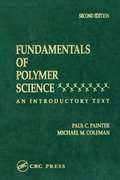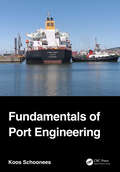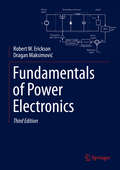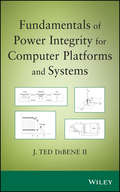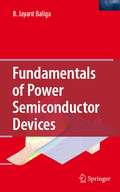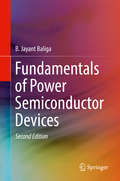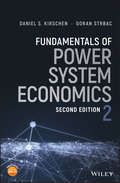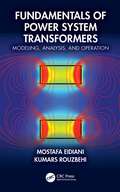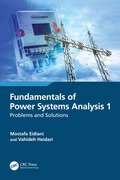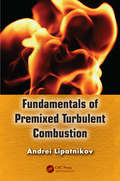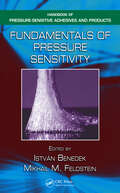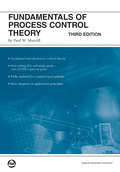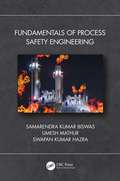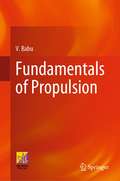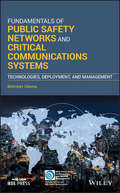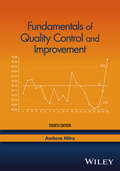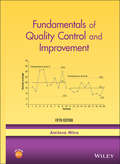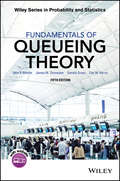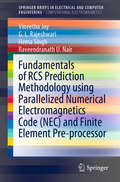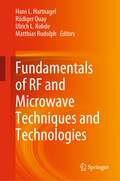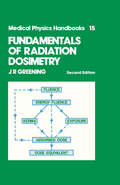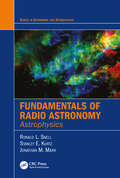- Table View
- List View
Fundamentals of Polymer Science: An Introductory Text, Second Edition
by Michael M. ColemanNow in its second edition, this widely used text provides a unique presentation of today's polymer science. It is both comprehensive and readable. The authors are leading educators in this field with extensive background in industrial and academic polymer research. The text starts with a description of the types of microstructures found in polymer
Fundamentals of Polymer-Clay Nanocomposites
by Gary W. Beall Clois E. PowellWritten for graduate students, researchers, and practitioners, this book provides a complete introduction to the science, engineering, and commercial applications of polymer-clay nanocomposites. Starting with a discussion of general concepts, the authors define specific terms used in the field, providing newcomers with a strong foundation to the area. The physical and mechanical properties of polymer-clay nanocomposites are then described, with chapters on thermodynamics and kinetics, engineering properties, barrier properties, and flame retardancy. Mechanisms underpinning observed effects, such as UV resistance, solvent resistance, and hardness, are also explained. In-depth discussions of clay and clay surface treatment, fabrication, and characterization of nanocomposites are provided, and particular emphasis is placed on the proper use and interpretation of analytical techniques, helping readers to avoid artifacts in their own work. With commercial applications discussed throughout, and experimental results connected with theory, this is an ideal reference for those working in polymer science.
Fundamentals of Port Engineering
by Koos SchooneesPort engineering primarily deals with the design, construction, operation, management, and maintenance of ports, overlapping with many other disciplines. This book provides an introductory text to prospective (graduate) port engineers and presents a wide variety of port subjects for practicing engineers. It covers almost all topics related to port engineering in a fundamental way, including dredging, marine aids to navigation, environmental issues, containers, liquid bulk, dry bulk, general cargo, multipurpose, roll-on/roll-off (Ro-Ro), fishing, and ferry terminals. Discussions are targeted at a conceptual design level. Other features: • Aspects of port engineering are discussed, including shipping, maritime trade, environmental aspects (such as climate change), resilience of ports, nature-based solutions, and port management (such as security, equipment, slurry pumping, and so forth).• Illustrates the design of port terminals.• Discusses site selection for a new port, the factors to be considered, and ways to compare different potential port sites.• Explores asset management and repair of marine structures.• Includes case studies from around the world, examples, and practical and user-friendly guidelines.
Fundamentals of Power Electronics
by Dragan Maksimović Robert W. EricksonFundamentals of Power Electronics, Third Edition, is an up-to-date and authoritative text and reference book on power electronics. This new edition retains the original objective and philosophy of focusing on the fundamental principles, models, and technical requirements needed for designing practical power electronic systems while adding a wealth of new material. Improved features of this new edition include: new material on switching loss mechanisms and their modeling; wide bandgap semiconductor devices; a more rigorous treatment of averaging; explanation of the Nyquist stability criterion; incorporation of the Tan and Middlebrook model for current programmed control; a new chapter on digital control of switching converters; major new chapters on advanced techniques of design-oriented analysis including feedback and extra-element theorems; average current control; new material on input filter design; new treatment of averaged switch modeling, simulation, and indirect power; and sampling effects in DCM, CPM, and digital control. Fundamentals of Power Electronics, Third Edition, is intended for use in introductory power electronics courses and related fields for both senior undergraduates and first-year graduate students interested in converter circuits and electronics, control systems, and magnetic and power systems. It will also be an invaluable reference for professionals working in power electronics, power conversion, and analog and digital electronics.
Fundamentals of Power Integrity for Computer Platforms and Systems
by Joseph T. Dibene IIAn all-encompassing text that focuses on the fundamentals of power integrityPower integrity is the study of power distribution from the source to the load and the system level issues that can occur across it. For computer systems, these issues can range from inside the silicon to across the board and may egress into other parts of the platform, including thermal, EMI, and mechanical.With a focus on computer systems and silicon level power delivery, this book sheds light on the fundamentals of power integrity, utilizing the author's extensive background in the power integrity industry and unique experience in silicon power architecture, design, and development. Aimed at engineers interested in learning the essential and advanced topics of the field, this book offers important chapter coverage of fundamentals in power distribution, power integrity analysis basics, system-level power integrity considerations, power conversion in computer systems, chip-level power, and more.Fundamentals of Power Integrity for Computer Platforms and Systems:Introduces readers to both the field of power integrity and to platform power conversionProvides a unique focus on computer systems and silicon level power delivery unavailable elsewhereOffers detailed analysis of common problems in the industryReviews electromagnetic field and circuit representationIncludes a detailed bibliography of references at the end of each chapterWorks out multiple example problems within each chapterIncluding additional appendixes of tables and formulas, Fundamentals of Power Integrity for Computer Platforms and Systems is an ideal introductory text for engineers of power integrity as well as those in the chip design industry, specifically physical design and packaging.
Fundamentals of Power Semiconductor Devices
by B. Jayant BaligaFundamentals of Power Semiconductor Devices provides an in-depth treatment of the physics of operation of power semiconductor devices that are commonly used by the power electronics industry. Analytical models for explaining the operation of all power semiconductor devices are shown. The treatment here focuses on silicon devices but includes the unique attributes and design requirements for emerging silicon carbide devices. The book will appeal to practicing engineers in the power semiconductor device community.
Fundamentals of Power Semiconductor Devices
by B. Jayant BaligaFundamentals of Power Semiconductor Devices provides an in-depth treatment of the physics of operation of power semiconductor devices that are commonly used by the power electronics industry. Analytical models for explaining the operation of all power semiconductor devices are shown. The treatment here focuses on silicon devices but includes the unique attributes and design requirements for emerging silicon carbide devices. The book will appeal to practicing engineers in the power semiconductor device community.
Fundamentals of Power System Economics
by Daniel S. Kirschen Goran StrbacA new edition of the classic text explaining the fundamentals of competitive electricity markets—now updated to reflect the evolution of these markets and the large scale deployment of generation from renewable energy sources The introduction of competition in the generation and retail of electricity has changed the ways in which power systems function. The design and operation of successful competitive electricity markets requires a sound understanding of both power systems engineering and underlying economic principles of a competitive market. This extensively revised and updated edition of the classic text on power system economics explains the basic economic principles underpinning the design, operation, and planning of modern power systems in a competitive environment. It also discusses the economics of renewable energy sources in electricity markets, the provision of incentives, and the cost of integrating renewables in the grid. Fundamentals of Power System Economics, Second Edition looks at the fundamental concepts of microeconomics, organization, and operation of electricity markets, market participants’ strategies, operational reliability and ancillary services, network congestion and related LMP and transmission rights, transmission investment, and generation investment. It also expands the chapter on generation investments—discussing capacity mechanisms in more detail and the need for capacity markets aimed at ensuring that enough generation capacity is available when renewable energy sources are not producing due to lack of wind or sun. Retains the highly praised first edition’s focus and philosophy on the principles of competitive electricity markets and application of basic economics to power system operating and planning Includes an expanded chapter on power system operation that addresses the challenges stemming from the integration of renewable energy sources Addresses the need for additional flexibility and its provision by conventional generation, demand response, and energy storage Discusses the effects of the increased uncertainty on system operation Broadens its coverage of transmission investment and generation investment Updates end-of-chapter problems and accompanying solutions manual Fundamentals of Power System Economics, Second Edition is essential reading for graduate and undergraduate students, professors, practicing engineers, as well as all others who want to understand how economics and power system engineering interact.
Fundamentals of Power System Transformers: Modeling, Analysis, and Operation
by Mostafa Eidiani Kumars Rouzbehi“Electric machines" and "Transformers" are some of the most challenging electrical engineering courses offered to students. Their complexity arises from numerous prerequisites, a wide array of topics, and a combination of physics and mathematics, presenting students with significant challenges.Fundamentals of Power System Transformers: Modeling, Analytics, and Operation acts as a stepping stone towards a deeper comprehension of the subject matter, resembling the content covered in a graduate-level course. The contents are condensed into two full chapters and four short chapters to provide a self-taught and self-sufficient book for students to solve all problems without the need for a computer.Key features include: A variety of tests to prepare for entrance or employment exams Comprehensive coverage of transformers analysis, control, and protection Numerous problems and solutions with varying degrees of difficulty Problems that can be solved solely using a calculator, without dependence on any computer-based software Two-choice questions to reinforce readers’ understanding of transformers concepts Explores not yet covered subjects including multi-winding auto-transformers, three-phase zigzag transformers, asymmetric and unbalanced three-phase transformers, special transformers, transformer control, and … This book is aimed at graduate students taking classes in electrical engineering and serves as a valuable reference for researchers and industry professionals interested in emerging technologies and innovations in power system transformers.
Fundamentals of Power Systems Analysis 1: Problems and Solutions
by Mostafa Eidiani Vahideh HeidariA supplementary book on power systems and their points is necessary for every successful student because the main books contain so much information. The supplementary book should include a summary, many tests, and an explanation of the answers. The structure in Fundamentals of Power System Analysis 1: Problems and Solutions is very helpful for re-reading and summarizing the information. This book can help you increase your study speed and master the important lessons if you are in the last few months of the semester and have not studied. This book is styled after national exams, with many varied tests with complete descriptive answers This book covers everything you need to know about power systems analysis A comprehensive and detailed examination of each image and figure has been conducted in this book. Students will be able to review points more quickly. It is particularly helpful before exams or national tests when you are under stress. It has the main advantage of providing an analysis of concepts and their combination. This allows students to better answer questions derived from several other subjects in a combined manner.
Fundamentals of Practical Environmentalism (Social Environmental Sustainability)
by Mark B. WeldonEnvironmental decisions present themselves every day in forms large and small. Should I walk to work today? What about global warming-should I write my congressperson and demand that the government do something? Should I put solar panels on my roof? Should I get a different car or turn up the temperature on the air conditioner or get water-saving f
Fundamentals of Premixed Turbulent Combustion
by Andrei LipatnikovLean burning of premixed gases is considered to be a promising combustion technology for future clean and highly efficient gas turbine combustors. Yet researchers face several challenges in dealing with premixed turbulent combustion, from its nonlinear multiscale nature and the impact of local phenomena to the multitude of competing models. Filling
Fundamentals of Pressure Sensitivity (Handbook of Pressure-Sensitive Adhesives and Products)
by Mikhail M. Feldstein István BenedekDiscussing the definition of pressure sensitivity and characterization of pressure-sensitive behavior, Volume 1 of the Handbook of Pressure-Sensitive Adhesives and Products presents the underlying theory beh
Fundamentals of Process Control Theory, 3rd Edition
by P. W. MurrillThis expanded and updated second edition includes drum level compensation equations, additional P&ID drawings and examples of permissive startup and tripping logic for gas, oil, and coal fired boilers. It also covers different control schemes for furnace draft control. NFPA 85 Code 2007 control system requirements are included, with illustrated examples of coal fired boilers, as well as information on the latest ISA-77 series of standards.
Fundamentals of Process Safety Engineering
by Samarendra Kumar Biswas Umesh Mathur Swapan Kumar HazraThis textbook covers the essential aspects of process safety engineering in a practical and comprehensive manner. It provides readers with an understanding of process safety hazards in the refining and petrochemical industries and how to manage them in a reliable and professional manner. It covers the most important concepts: static electricity, intensity of thermal radiation, thermodynamics of fluid phase equilibria, boiling liquid expanding vapor explosion (BLEVE), emission source models, hazard identification methods, risk control and methods for achieving manufacturing excellence while also focusing on safety. Extensive case studies are included. Aimed at senior undergraduate and graduate chemical engineering students and practicing engineers, this book covers process safety principles and engineering practice authoritatively, with comprehensive examples: • Fundamentals, methods, and procedures for the industrial practice of process safety engineering.• The thermodynamic fundamentals and computational methods for release rates from ruptures in pipelines, vessels, and relief valves.• Fundamentals of static electricity hazards and their mitigation.• Quantitative assessment of fires and explosions.• Principles of dispersion calculations for toxic or flammable gases and vapors.• Methods of qualitative and quantitative risk assessment and control.
Fundamentals of Propulsion
by V. BabuThis highly informative book offers a comprehensive overview of the fundamentals of propulsion. The book focuses on foundational topics in propulsion, namely gas dynamics, turbomachinery, and combustion to more complex subjects such as practical design aspects of aircraft engines and thermodynamic aspects and analysis. It also includes pedagogical aspects such as end-of-chapter problems and worked examples to augment learning and self-testing. This book is a useful reference for students in the area of mechanical and aerospace engineering. Also, scientists and engineers working in the areas of aerospace propulsion and gas dynamics find this book a valuable addition.^
Fundamentals of Public Safety Networks and Critical Communications Systems: Technologies, Deployment, and Management (IEEE Press Series on Networks and Service Management)
by Mehmet UlemaA timely overview of a complete spectrum of technologies specifically designed for public safety communications as well as their deployment as management In our increasingly disaster-prone world, the need to upgrade and better coordinate our public safety networks combined with successful communications is more critical than ever. Fundamentals of Public Safety Networks and Critical Communications Systems fills a gap in the literature by providing a book that reviews a comprehensive set of technologies, from most popular to the most advanced communications technologies that can be applied to public safety networks and mission-critical communications systems. The book explores the technical and economic feasibility, design, application, and sustainable operation management of these vital networks and systems. Written by a noted expert in the field, the book provides extensive coverage of systems, services, end-user devices, and applications of public-safety services and technologies. The author explores the potential for advanced public safety systems, and this comprehensive text covers all aspects of the public safety and critical communications network field. This important book: Provides an introduction to and discussion of the common characteristics of our critical communications systems Presents a review of narrowband technologies such as Project 25, TETRA, and DMR as well as the broadband technologies such as the LTE technology Focuses on the emerging technologies that can be adopted to improve our vital communications systems Discusses deployment of such technologies, including economics and finance, planning and project management Provides, in detail, the issues and solutions related to the management of such communications networks Offers a complete list of standards documents Written for professionals in the industry, academics, and government and regulatory agencies, Fundamentals of Public Safety Networks and Critical Communications Systems offers a review of the most significant safety technologies, explores the application for advanced technologies, and examines the most current research.
Fundamentals of Public Utilities Management
by Frank R. SpellmanFundamentals of Public Utilities Management provides practical information for constructing a roadmap for successful compliance with new and ever-changing regulatory frameworks, upgrading and maintenance, and general management of utilities operations. It describes current challenges faced by utility managers and offers best practices. In an effort to maximize the usefulness of the material for a broad audience, the text is written in a straightforward, user-friendly, conversational style for students and practicing professionals alike. Features: Presents numerous illustrative examples and case studies throughout Examines environmental compliance and how to best work with continually changing regulations Frames the discussions in a context of energy conservation and ongoing sustainability efforts Fundamentals of Public Utilities Management is designed to provide insight and valuable information to public utility sector managers and prospective managers in water operations (drinking water, wastewater, storm water), and to serve the needs of students, teachers, consulting engineers, and technical personnel in city, state, and federal public sectors.
Fundamentals of Quality Control and Improvement
by Amitava MitraA statistical approach to the principles of quality control and managementIncorporating modern ideas, methods, and philosophies of quality management, Fundamentals of Quality Control and Improvement, Third Edition presents a quantitative approach to management-oriented techniques and enforces the integration of statistical concepts into quality assurance methods. Utilizing a sound theoretical foundation and illustrating procedural techniques through real-world examples, this timely new edition bridges the gap between statistical quality control and quality management.The book promotes a unique "do it right the first time" approach and focuses on the use of experimental design concepts as well as the Taguchi method for creating product/process designs that successfully incorporate customer needs, improve lead time, and reduce costs. Further management-oriented topics of discussion include total quality management; quality function deployment; activity-basedcosting; balanced scorecard; benchmarking; failure mode and effects criticality analysis; quality auditing; vendor selection and certification; and the Six Sigma quality philosophy.The Third Edition also features:Presentation of acceptance sampling and reliability principlesCoverage of ISO 9000 standardsProfiles of past Malcolm Baldrige National Quality Award winners, which illustrate examples of best business practicesStrong emphasis on process control and identification of remedial actionsIntegration of service sector examplesThe implementation of MINITAB software in applications found throughout the book as well as in the additional data sets that are available via the related Web siteNew and revised exercises at the end of most chaptersComplete with discussion questions and a summary of key terms in each chapter, Fundamentals of Quality Control and Improvement, Third Edition is an ideal book for courses in management, technology, and engineering at the undergraduate and graduate levels. It also serves as a valuable reference for practitioners and professionals who would like to extend their knowledge of the subject.
Fundamentals of Quality Control and Improvement
by Amitava MitraThe newest edition of an insightful and practical statistical approach to quality control and management In the newly revised and thoroughly updated Fifth Edition of Fundamentals of Quality Control and Improvement, accomplished academic, consultant, and author Dr. Amitava Mitra delivers a comprehensive and quantitative approach to quality management techniques. The book demonstrates how to integrate statistical concepts with quality assurance methods, incorporating modern ideas, strategies, and philosophies of quality management. You'll discover experimental design concepts and the use of the Taguchi method to incorporate customer needs, improve lead time, and reduce costs. The new edition also includes brand-new case studies at the end of several chapters, references to the statistical software Minitab 19, and chapter updates that add discussions of trending and exciting topics in quality control. The book includes access to supplementary material for instructors consisting of a new instructor's solutions manual and PowerPoint slides, as well as access to data sets for all readers. Readers will also benefit from the inclusion of: A thorough introduction to the evolution of quality and definitions of quality, quality control, quality assurance, quality circles, and quality improvement teams An exploration of customer needs and market share, as well as the benefits of quality control and the total quality system Practical discussions of quality and reliability, quality improvement, product and service costing, and quality costs A concise treatment of how to measure quality costs, the management of quality, and the interrelationship between quality and productivity Perfect for upper-level undergraduate and graduate students in quality control and improvement, the Fifth Edition of Fundamentals of Quality Control and Improvement will also earn a place in the libraries of business students and those undertaking training programs in Six Sigma.
Fundamentals of Queueing Theory (Wiley Series in Probability and Statistics)
by Donald Gross John F. Shortle Carl M. Harris James M. ThompsonThoroughly updated and expanded to reflect the latest developments in the field, Fundamentals of Queueing Theory, Fifth Edition presents the statistical principles and processes involved in the analysis of the probabilistic nature of queues. Rather than focus narrowly on a particular application area, the authors illustrate the theory in practice across a range of fields, from computer science and various engineering disciplines to business and operations research. Critically, the text also provides a numerical approach to understanding and making estimations with queueing theory and provides comprehensive coverage of both simple and advanced queueing models. As with all preceding editions, this latest update of the classic text features a unique blend of the theoretical and timely real-world applications. The introductory section has been reorganized with expanded coverage of qualitative/non-mathematical approaches to queueing theory, including a high-level description of queues in everyday life. New sections on non-stationary fluid queues, fairness in queueing, and Little’s Law have been added, as has expanded coverage of stochastic processes, including the Poisson process and Markov chains.
Fundamentals of RCS Prediction Methodology using Parallelized Numerical Electromagnetics Code (SpringerBriefs in Electrical and Computer Engineering)
by Hema Singh Raveendranath U. Nair Vineetha Joy G. L. RajeshwariThis book presents a novel methodology for the computation of RCS of metallic structures using a parallelized version of NEC in conjunction with a finite element preprocessor which has been strategically incorporated for simplifying geometry modelling catering to NEC guidelines. It includes a thorough overview of the theoretical background of NEC including all relevant aspects of formulation and modelling. The revised methodology including all the required steps and details is discussed elaborately along with case studies and validations. This book will serve as a valuable resource for students, researchers, scientists, and engineers working in the field of RCS predictions and measurements.
Fundamentals of RF and Microwave Techniques and Technologies
by Ulrich L. Rohde Matthias Rudolph Hans L. Hartnagel Rüdiger QuayThe increase of consumer, medical and sensors electronics using radio frequency (RF) and microwave (MW) circuits has implications on overall performances if design is not robust and optimized for a given applications. The current and later generation communication systems and Internet of Thing (IoT) demand for robust electronic circuits with optimized performance and functionality, but low cost, size, and power consumption. As a result, there is a need for a textbook that provides a comprehensive treatment of the subject. This book provides state-of-the-art coverage of RF and Microwave Techniques and Technologies, covers important topics: transmission-line theory, passive and semiconductor devices, active and passive microwave circuits and receiver systems, as well as antennas, noise and digital signal modulation schemes. With an emphasis on theory, design, and applications, this book is targeted to students, teachers, scientists, and practicing design engineers who are interested in broadening their knowledge of RF and microwave electronic circuit design. Readers will also benefit from a unique integration of theory and practice, provides the readers a solid understanding of the RF and microwave concepts, active and passive components, antenna, and modulation schemes. Readers will learn to solve common design problems ranging from selection of components, matching networks to biasing and stability, and digital modulation techniques. More importantly, it provides basic understanding in the analysis and design of RF and microwave circuits in a manner that is practiced in industry. This make sure that the know-how learned in this book can be effortlessly and straightway put into practice without any obstacles.
Fundamentals of Radiation Dosimetry (Series in Medical Physics and Biomedical Engineering #Vol. 15)
by J.R GreeningThis book reviews ionising radiation quantities and the relationships between them and discusses the principles underlying their measurement. The emphasis is on the determination of absorbed dose and related dosimetric quantities.
Fundamentals of Radio Astronomy: Astrophysics (Series in Astronomy and Astrophysics)
by Stanley Kurtz Ronald L. Snell Jonathan MarrAs demonstrated by five Nobel Prizes in physics, radio astronomy has contributed greatly to our understanding of the Universe. Courses covering this subject are, therefore, very important in the education of the next generation of scientists who will continue to explore the Cosmos. This textbook, the second of two volumes, presents an extensive introduction to the astrophysical processes that are studied in radio astronomy. Suitable for undergraduate courses on radio astronomy, it discusses the physical phenomena that give rise to radio emissions, presenting examples of astronomical objects, and illustrating how the relevant physical parameters of astronomical sources can be obtained from radio observations. Unlike other radio astronomy textbooks, this book provides students with an understanding of the background and the underlying principles, with derivations available for most of the equations used in the textbook. Features: Presents a clear and concise discussion of the important astronomical concepts and physical processes that give rise to both radio continuum and radio spectral line emission Discusses radio emissions from a variety of astronomical sources and shows how the observed emissions can be used to derive the physical properties of these sources Includes numerous examples using actual data from the literature
